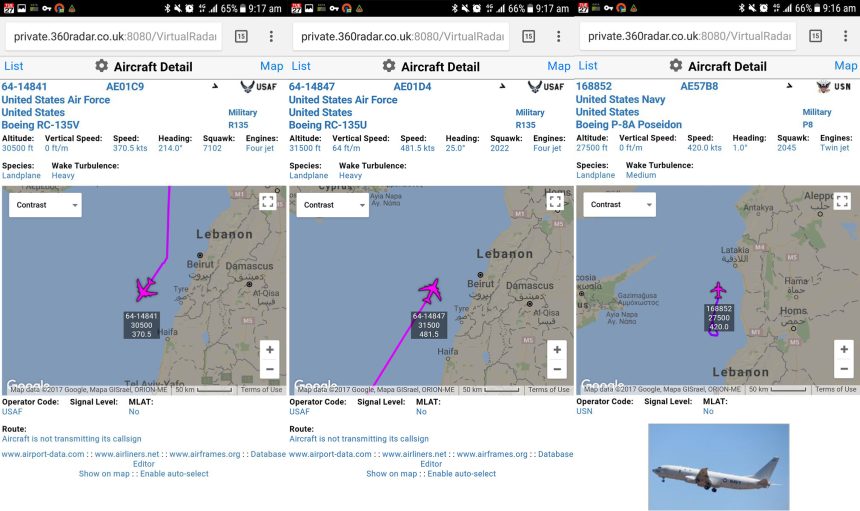U.S. RC-135 Rivet Joint and other spyplanes operating in international airspace off Syria. While a WC-135 “nuke sniffer” flew towards the Black Sea.
The White House’s warning about an imminent chemical attack and the visit Assad paid to Hmeymim airbase, near Latakia, today are among the most likely reasons for a rather unusual presence of U.S. spyplanes off Syria in the last couple of days.
Once again, the hint of a busy intelligence gathering operation underway along the coasts of western Syria comes from the signals collected by aircraft spotters, airband listeners and ADS-B monitors, who have reported the movements of U.S. Air Force RC-135s along with a U.S. Navy P-8 Poseidon aircraft.
Among those who have tracked the flights, the famous ADS-B / ModeS tracking enthusiast running the popular @CivMilAir and @ADSBTweetBot Twitter feeds, who has traced the missions of one RC-135U Combat Sent (that had already operated in the same area yesterday), one RC-135V Rivet Joint and one P-8 Poseidon on Jun. 27, more or less as Assad posed for some photos inside the cockpit of a Russian Sukhoi deployed to Syria.
After chem weapons accusations defiant #Assad visits Russian air base. US a/c carrier+intel planes buildup in Med@AnshelPfeffer @CivMilAir pic.twitter.com/rNsoVGBvhW
— avi scharf (@avischarf) 27 June 2017
The Rivet Joint is the USAF’s standard (SIGINT) gathering platform, meaning that it can eavesdrop and pinpoint “enemy” radio signals, and disseminate the details about these targets via tactical data-link to other aircraft, while the Combat Sent is designed to collect technical intelligence on adversary radar emitter systems. The P-8 is the U.S. Navy’s multi-role surveillance platform with the ability to snoop enemy communications and signals. In other words, three of the most important ISR (Intelligence Surveillance Reconnaissance) assets in the U.S. inventory were flying in the airspace off Lebanon and Syria earlier today: were they flying there at the same time by accident? Or, as it seems more likely, they were looking for something specific?
2X RC-135 Combat sent + Rivet Joint in E med. Yesterday 1 snooped #Syria shores, then WH warned of chem attack. Same tracks today? https://t.co/EI8zVDFMER
— avi scharf (@avischarf) June 27, 2017
Another interesting movement that might be related to the situation in Syria was the WC-135 Constant Phoenix “nuke sniffer” that, using the radio callsign “Lando 90” flew from RAF Mildenhall, where it deployed on Jun. 22, towards the Black Sea on Jun. 26. Although the atmospheric collections aircraft used to detect the radioactive particles that result from a nuclear detonation, could be on a “pre-planned deployment” (as the official press release usually state regardless of the actual reason behind the presence of the WC-135 around the world…) it has long been speculated that it can carry sensors even capable to detect chemical substances down wind from the attack area days, or week after they were dispersed.
Once again, it might be a coincidence. Or not.
Nuke sniffer – 33,000ft heading over Romania…
?? USAF WC135C 62-3582 LANDO90 pic.twitter.com/KOBkOs9i1U
— CivMilAir ✈ ? (@CivMilAir) 26 June 2017
H/T @avischarf. Image credit: @CivMilAir









